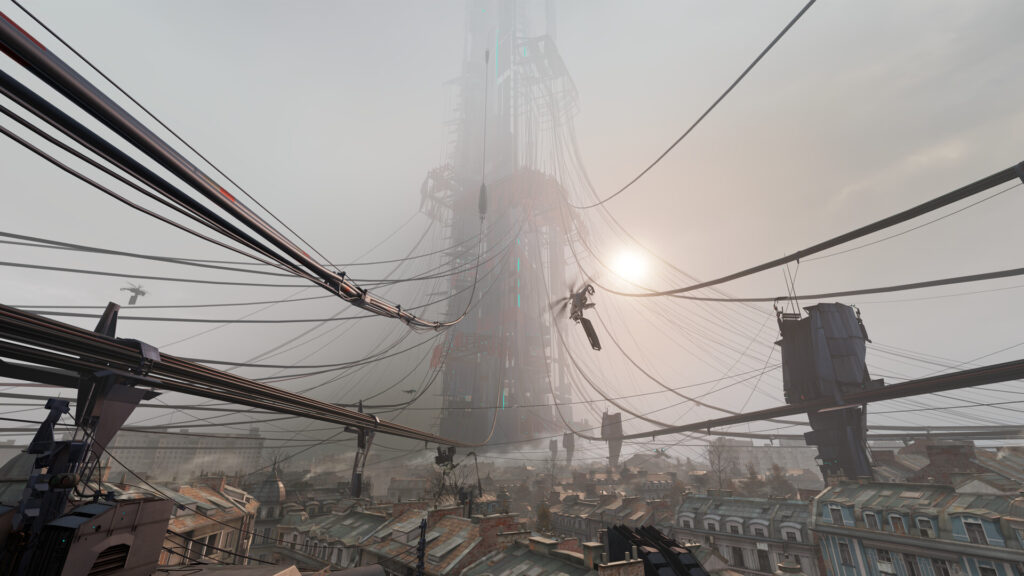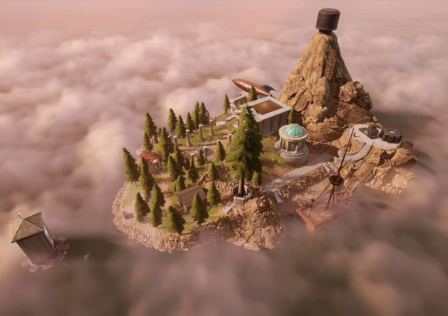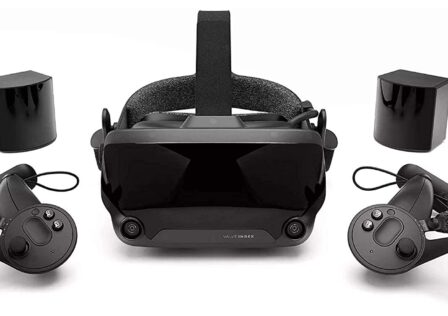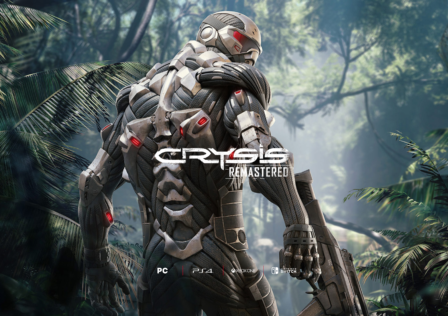Half-Life: Alyx released on March 23, 2020, and really shook up the gaming world. There’s so much praise that it’s hard to get any objective feedback about the game, most people simply claim it’s the greatest thing ever or something to that effect. But just how good is it really? How does it compare to the other games in the series? Obviously the hype is largely due to it being the first VR exclusive game that’s an actual game rather than just a tech demo, but our review will look past that.
I played Half-Life: Alyx on the Valve Index kit. Delays for Index deliveries is the main reason this review is so late, but better late than never.
The Game Itself
Half-Life: Alyx is a prequel to Half-Life 2 in which you unsurprisingly take the role of Alyx Vance. Despite being a prequel, this game absolutely should not be played before Half-Life 2 and its expansions, it must be played after all of them. This game is 7-8 hours in length and it really plays it safe in order to be a comfortable VR experience. I’d say it plays it too safe, as far as general game design goes.
The plot is simple from the beginning: Eli is abducted by the Combine and taken into a quarantine zone, which you must breach and navigate in order to rescue him. Obviously you are successful in rescuing him since Eli is pivotal in Half-Life 2 which takes place after this. Eli manages to escape with encrypted Combine data, which he decrypts throughout most of the game, feeding you information from it, which initially reveals the presence of some kind of heavily guarded Combine superweapon which becomes your next goal.
Throughout the game, you’re in radio communication with Russell, a fellow resistance member who shares stories throughout the game, often about how Earth was like before the Combine invasion. There is an interesting dynamic in place between the veteran Russell and the young Alyx, and the quirky humor brought up between the two often resembles the humor seen in modern mainstream movies such as Star Wars, which is also present in some of the Vortigaunt encounters in the game. This humor is different than the nerdier, more dry humor from the previous games, conforming more to what’s popular today which I’m not a fan of personally.
As the plot advances, some surprises are thrown your way regarding the nature of this superweapon. Usually not all too surprising, but intriguing nonetheless. But then a sharp twist in the plot manifests on the final level of the game.
Story Spoilers Begin Here!
Much has been made about this twist, the final level and the ending of Half-Life: Alyx. Had it not been the game to open up lots of people to the idea of VR gaming, much controversy would have been born from this ending, as far less controversial endings have been flamed in gaming in the past. The final level is like something out of a Christopher Nolan movie, no doubt appealing to the masses for similar reasons. It is certainly a memorable experience. Earlier in the game, data decrypted by Eli reveals that the so called Combine superweapon isn’t a superweapon, but rather a prison. It is believed to house Gordon Freeman, so you’re led to to believe much of the game that Alyx will segue straight into Half-Life 2 with the freeing of Gordon Freeman.
But the final level reveals that it’s not Gordon Freeman that’s imprisoned, but G-Man. This is not terribly surprising, but a cool twist regardless. The controversy from the ending comes from the major retcon that happens; for rescuing G-Man, he rewards you by undoing Eli’s death at the end of Half-Life 2: Episode Two. The game then fast forwards to this moment, with Eli alive, Alyx having disappeared, and you (now Gordon Freeman) setting off with Eli to find out what happened to Alyx.
Anytime a retcon takes place to undo a main character’s death, controversy typically ensues, and I believe Alyx only avoided this controversy because it was so beloved for being the first real VR exclusive game. This does open up a lot of questions and concerns for plot holes, but really we’ll have to wait for the next game to see just where this leads.
Spoilers End Here!
Here is a breakdown of the technical features of the game:
| 64-bit | Yes |
|---|---|
| Linux Support | Native |
| Graphics API | DirectX 11 |
| Frame Rate | Unlockable |
| High Resolution Support | Yes |
| Ultrawide Support | No (VR exclusive game) |
| High Refresh Rate Support | Yes |
| VR | Yes (exclusive) |
| Display HDR | No |
| Ray Tracing | No |
| Multicore CPU Support | 4-8 cores |
| Anisotropic Filtering | 16x |
| Anti-Aliasing | 4x MSAA, Downsampling |
| Sound API | XAudio2 |
| Sound | 2 channels |
| UI Scaling | Yes |
| Debug Console | Yes |
| Modding | Yes (SDK) |
Gameplay Overview
Because of its VR nature, Alyx is a much slower paced game than the other Half-Life games, and it is actually a claustrophobic survival horror game. Both Half-Life and Half-Life 2 have more survival horror-esque sections, which are often also similarly claustrophobic, but other chapters in the other games vary wildly which is one of the strengths of those games – excellent diversity for an FPS. Half-Life: Alyx, on the other hand, never opens up. It is almost like Half-Life 2 meets Resident Evil, without most of the nonsense and gameplay deficiency of Resident Evil.
But I do wish the game would’ve opened up more, at some point. Simply because it’s Half-Life, and the scale of Half-Life levels varied far more throughout the previous games. I expected that diversity from the latest Half-Life game, but alright, this is a different take, claustrophobic survival horror throughout. Combine encounters and the ensuing combat likewise lean on the survival elements rather than the action elements, as you fight fewer enemies compared to the climactic moments of the previous games, so the claustrophobic level design and the VR experience are meant to increase the intensity of these smaller scale combat encounters.
At the end of the day, Half-Life: Alyx never manages the same level of gameplay diversity of its predecessors. It does introduce some new cool alien enemy types, I look forward to having them in the next game while hopefully also getting back the diversity of action and encounters from the previous games. Every combat encounter in Alyx is a claustrophobic survival experience, and the “puzzle” gameplay is surprisingly dull and lackluster.
Whereas both Half-Life and Half-Life 2 have many different types of physics based problem solving elements (or “puzzles”), platforming sections (often mixed with the physics), and other obstacles that involve interacting with the environment in different ways to figure out how to advance, almost all of the puzzle gameplay in Alyx is either using the “Alyx” multitool to reroute power lines inside walls/ceilings/floor to power up the environment, and also doing hacking minigames with this tool. This gets old fast, it’s a clear decline from the more varied and satisfying puzzle gameplay from the previous games.
So the overall gameplay loop of Half-Life: Alyx is pretty simple; claustrophobic survival-focused combat encounters, repetitive “puzzle” gameplay to navigate constantly small but artistically distinct environments. I think now we can focus more on the VR specific elements of Half-Life: Alyx which includes more of the gameplay mechanics.
The VR Experience
Of course the first thing you’re going to notice about Half-Life: Alyx is that it’s visually remarkable. It has all the standard VR movement options and even more: Blink, Shift, Continuous and Continuous Hand. Blink is your usual VR teleporting, Continuous is your usual smooth movement that uses both the left analog stick and your actual movement around your space. I use Continuous exclusively.
Being inside City-17 is almost like a dream come true for Half-Life 2 fans, and it’s a far more detailed City-17 obviously. Half-Life 2’s level design details were never great, hence why Cinematic Mod map improvements were much appreciated, making the locations feel more like actual places and less like 2004 video game maps.
But Alyx is on a different level with environmental attention to detail. Obviously you can interact with almost every object in the environment, and do things like write with markers and erase writing, wear some random articles of clothing in the environment, play around with the physics. Although I must say, for those thinking this is unique to VR, stop and go play a game made by Frictional Games.
The technical graphics quality of Half-Life: Alyx stands as strong as its art design, it’s a very good looking game, striking a great balance between visuals and performance for VR gaming. One interesting thing is the amount of dark environments present in the game, which is a bad match for Valve’s own Index VR headset which uses an LCD screen which has terrible black depth. There is a flashlight item but it is only used automatically and doesn’t even trigger in all dark environments, which is an annoying shortcoming.
But you don’t see too much of the city itself in Half-Life: Alyx, as most of the game takes place in its quarantine zone. This area contains more Xen inspired alien elements, infesting this world making for a claustrophobic apocalyptic inspired setting. You will see lots of places overgrown with earthly vegetation, alien vegetation, or both, you will navigate collapsed buildings and other structures, and this ruined environment is full of obstacles leading to the aforementioned overly repetitive puzzle gameplay.
There’s a lot of attention to detail in the world of Half-Life: Alyx that improves VR immersion further, such as seeing with your own eyes the disturbing way the healing machines work, the placement of some of the enemies, the hacking minigames being 3D holograms, and some of the weapon details such as the “reflex sight” actually being a hologram (they should’ve called it a holographic sight). This brings us to our next section.
Shooting Mechanics
There are only three guns in Half-Life: Alyx, although the final level presents you with something comparable to Half-Life 2’s Blue Gravity Gun. The first gun you get in Half-Life: Alyx is a customized 1911 pistol with a compensator, futuristic ammo indicator, and iron sights that combine the best of fiber optics and tritium illumination (they always glow). Eventually you find a semi-auto shotgun that has some SPAS-12 parts and a screen displaying the current number of shells in the gun, but is overall a custom DIY-looking design with a folding stock which you sadly can’t use and a break open design for reloading one shell at a time. Lastly you get one Combine gun; a submachine gun (SMG) that seems to fire the same ammo as the Pulse Rifle from Half-Life 2.
What sets these guns apart is the attention to detail in the weapon mechanics, and the upgrade system. Guns have just about all the detail a true gun nut would desire. Take the 1911 pistol for example; you can move the slide back at will to see whether or not it’s chambered, bring it all the way back to eject the cartridge if it is chambered (losing it for good), and because the chamber is actually separate you can have a round in the chamber + a full magazine in the gun at once. But you can’t interact with the safety levers on any gun, like how you can’t extend the stock on the shotgun.
The upgrade system is fantastic. Not revolutionary, just more detailed versions of what other games have. You can get a laser sight upgrade on all guns (and pseudo-blind yourself with it if you want to), every gun has a different ammo capacity upgrade, and much more. The shotgun can be upgraded to fire hand grenades, like a rifle grenade system so it can only hold one at a time. The game also has both regular hand grenades and Xen grenades, this grenade launcher can hold both. The shotgun can be upgraded to have a cartridge belt on the side, and an auto reload system so that you can just press the button to break open the magazine of the gun and it will reload itself.
If you upgrade the magazine capacity on the pulse SMG, the reload mechanism changes entirely; by default you can just put a magazine cell into the feeding port of the gun, it will load automatically and the now depleted magazine will drop to the ground. But if you upgrade the magazine capacity of the gun, you now have to press a button to open the feed system, and close it by hand after.
These are just some examples but the attention to detail and the guns themselves are lovely. What Alyx is missing in combat is melee combat; you can pick up a 2×4, lead pipe, a brick, all sorts of deadly objects but you can’t use them in melee.
Other Gameplay Mechanics
Ammo is stored in your backpack along with resin which is used for weapon upgrades in designated machines. Items are placed into and retrieved from your backpack by reaching over your shoulder and grabbing using finger detection. You also have one inventory slot on each wrist which can hold one item, particularly either a grenade or healing stimulant which also has cool mechanics.
On that note, one flaw in Alyx’s design is its reliance on finger detection. The Index controller is just not great at detecting when your fingers are closed while you’re moving your hands; problems like this arise in most if not all games that heavily rely on it. In Half-Life: Alyx specifically, tasks that require maintaining a grip such as rotating a wheel can be next to impossible, even if not sweaty at all, as your grip will constantly let go despite you holding onto it. This is especially problematic in one chapter of the game, Jeff, when you must rotate a wheel in a very small time window before an invincible mutated enemy one hit kills you. I was unable to do this, the grip kept letting go of itself, even when my hands weren’t sweaty, so I had to cheat and noclip past this section.
The controller’s deficiencies are known, so this issue could’ve been avoided by making it so the grip button has to be pressed in order to be gripping something in-game, but this is not how it works sadly. Another flawed gameplay element are ladders, which were iffy in Source engine too. Be very careful with ladders.
The AI is typical of Half-Life – relatively advanced, but forgiving. They have detailed behaviors and actually acknowledge each other, but from a tactical perspective are deliberately held back. Here is a good video below that demonstrates.
Sound Design
Half-Life: Alyx is built for stereo output devices only, it doesn’t support any other mode since it’s a VR only game intended to be used with either the Index’s built in earspeakers or another VR headset + headphones. This took some getting used to for me since I’m new to VR and used to gaming on my much higher fidelity surround sound system opposed to stereo only, relatively low fidelity headphones/earspeakers.
It’s a shame that no VR game will ever have the ideal audio solution, which is surround sound support with 3D HRTF that keeps in mind where the player is and where they’re looking, so that for example the surround channels can become the front channels when needed and vice versa and everything in between.
There is a lot of attention to detail in sound effects, particularly object detail, e.g. you can grab a sealed can, shake it around and hear something moving around inside, and there isn’t just one instance of this but lots of different sounds for objects like these. Environmental sound cues are very important, especially for a VR game, and Alyx doesn’t disappoint. The ambient sounds are also detailed, very organic in infested areas, it all really add to the atmosphere.
The game also has excellent sound effects for gunshots, far surpassing the other games in the series. It doesn’t seem to have the most advanced environmental sound processing ever, but the game does have a strong spatial sound HRTF that sounds binaural.
Half-Life 2 was known for its soundtrack, and I like Alyx’s even more. Alyx being a different kind of game calls for a different kind of soundtrack of course, something more suited for a survival focused game rather than a fast paced action game, and Mike Morasky really delivers. Much has been made of the new voice actors in Alyx. They do a solid job all around, with the new Alyx sounding like a younger Alyx which is fitting for the game.
Conclusion
No, Half-Life: Alyx is not the greatest game ever made like a lot of the early hype suggests. Based on its merits, it ranks as weaker than both Half-Life and Half-Life 2 due to having much less diversity in scale, puzzle gameplay, combat encounters and action sequences. Half-Life: Alyx really needs VR to stand out. It’s an easily translatable game to non-VR; if it wasn’t VR then it’d be like Half-Life 2 meets Resident Evil. It’d be a more survival horror focused Half-Life with much less varied gameplay content. Because Half-Life: Alyx isn’t terribly strong in content, but is strong in visuals, it really benefits from being a VR game even if it plays it too safe.
But the opposite is not true, the previous Half-Life games would not explicitly benefit from VR. Half-Life: Alyx is an interesting study into VR gaming if anything; it is ultimately a very familiar game formula with very detailed visuals and object interaction making it great for VR, whereas the first two Half-Life games, especially the second, are too fast paced and too demanding on player performance to be VR games. Half-Life 2’s adrenaline filled vehicle sections, the Highway 17 bridge where you’re fighting Combine, Hunter-Choppers, while doing utmost precise platforming where it’s very easy to fall off and die, those are just too much for VR. This is also evident in games like Serious Sam VR on “intended” difficulty modes like Serious. Not many people want such demanding games in VR.
Nevertheless, I would’ve liked Half-Life: Alyx to at least open up more. Going for a survival horror focused game is fine, but Half-Life just always had many levels that provided very different scale and gameplay from other levels. Also, Alyx’s puzzle gameplay really needs to be more creative than it is.
Strengths
- Incredibly detailed visual and sound design
- Excellent world interaction
- Good enemy design, I look forward to seeing some of these new ones in the next game
- Revolutionary VR weapon handling and shooting mechanics. Utterly unparalleled in attention to detail here.
- Good plot progression, unravels twists in an interesting manner
Weaknesses
- Puzzle gameplay is too repetitive and simple, big downgrade from the previous games in this regard
- The game plays it too safe, never opening up and introducing quite enough gameplay variety for encounters, combat, puzzles, platforming, functional level design
- No melee combat at all is a disappointment. Can you imagine Half-Life: Alyx’s shooting combined with Blade and Sorcery’s melee combat?
- Imprecise melee hitboxes from enemies, so you can’t duck under swings and distance/reach is inaccurate
- Relying on finger tracking for gripping objects is unreliable
- Be careful with ladders, they are glitchy and unreliable and will get you killed
- The teleport movement that you need to get past some gaps and obstacles is glitchy, unreliable and will get you killed. Most or all of your deaths in this game will be caused by the above two unreliable mechanics and unclear scripted fall damage that looks like it’d be nothing but kills you anyway.
- The Russells’ (Gravity Gloves) detection of what object you’re pointing at is inaccurate and doesn’t prioritize actual usable objects, and sometimes even distance isn’t prioritized
- The flashlight needs to be manually controlled, not just automatic since there were many times I wanted to use it but couldn’t (a mod fixes this)
- Controversial ending decision, but we need to see how it pans out in the next game
- While the physics engine is improved from original Source, it’s still glitchy and easy to make solid objects collide into/through each other. Amazing that this hasn’t been solved yet in video game physics. This flaw can lead to important objects disappearing.
- Very long loading times, unusual for a modern game, especially a small scale one like this
- Disappointing modding limitations for a Half-Life game with an SDK
- As good as the weapon handling is, it’s missing some things. You can’t unfold the stock on the shotgun, you can’t load magazines or put a round in the chamber yourself even though you can eject individual cartridges (likewise you can’t push cartridges out of magazines).
- Can’t disable tooltips/hints, and in-game they last until you do what they tell you (no timed expiration)
- VR settings reset themselves every time you start a new game, even modded games
- Some badly scaled objects like apartment doors having their peepholes far above eye level (it’s like 190cm from the ground)
- Can’t drink vodka in the distillery. Okay, this one is not a real weakness, but come on!
Overall the pros outweigh the cons, although Half-Life: Alyx is no masterpiece. Nevertheless I do recommend playing it, certainly a must-play VR experience.





 (6 votes, average: 3.67 out of 5)
(6 votes, average: 3.67 out of 5)







